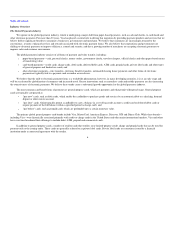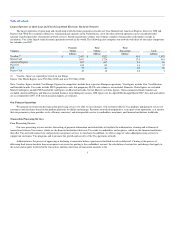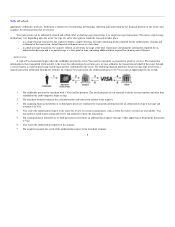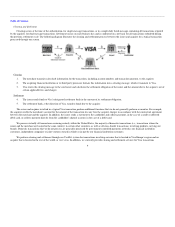Visa 2008 Annual Report Download - page 17
Download and view the complete annual report
Please find page 17 of the 2008 Visa annual report below. You can navigate through the pages in the report by either clicking on the pages listed below, or by using the keyword search tool below to find specific information within the annual report.
Table of Contents
Our fraud detection and prevention offerings include Verified by Visa, a global Internet authentication product, which permits cardholders to
authenticate themselves to their issuing financial institution using a unique personal code; Visa Advanced Authorization, which adds additional fraud
detection capability by adding real-time risk scores to authorization messages; and chip and PIN programs that have been demonstrated to reduce the
incidence of certain types of fraud at physical point of sale locations. We have also implemented rules that require the use of more secure PIN encryption
standards for ATMs and point-of-sale PIN entry devices installed after 2002 and 2003, and we have recently mandated that all PINs transmitted through
VisaNet to the issuer be encrypted using the Triple DES, or Data Encryption Standard, by July 1, 2010.
In a 2006 cooperative industry effort, we co-founded the Payment Card Industry (PCI) Data Security Standards Council, an independent council that
established security standards to protect cardholder data and to prevent fraud. In late 2006, we introduced a PCI compliance program with both incentives and
fines targeted at our largest acquirers in order to improve compliance with the PCI standards by our largest U.S.-based merchants, which we refer to as Level I
and Level II merchants. The initiative's goal is to eradicate the storage of prohibited account data, such as magnetic stripe (also known as track data), CVV2
(the three-digit security code on the back of the card) and PIN data, and to improve PCI compliance among this group of merchants.
Interchange
Interchange represents a transfer of value between the financial institutions participating in an open-loop payments network such as ours. On purchase
transactions, interchange fees are typically paid to issuers by acquirers in connection with transactions initiated with cards in our payments system. We set
default interchange rates in the United States and other regions. In certain jurisdictions, interchange rates are subject to government regulation. Although we
administer the collection and remittance of interchange fees through the settlement process, we generally do not receive any portion of the interchange fees.
Interchange fees are often the largest component of the costs that acquirers charge merchants in connection with the acceptance of payment cards. We believe
that interchange fees are an important driver of system volume.
We believe the default interchange rates that we use promote the efficient operation of our payments network by enabling both the issuer and acquirer
to understand the economics of a given transaction before entering into it, and by eliminating the need for each of our customers to negotiate transfer pricing
with each other. By establishing and modifying default interchange rates in response to marketplace conditions and strategic demands, we seek to ensure a
competitive value proposition for transactions using our cards in order to encourage electronic transactions and to maximize participation in the Visa
payments system by issuers and acquirers and, ultimately, consumers and merchants. We believe that proper management of interchange rates benefits
consumers, merchants, our customers and us by promoting the overall growth of our payments network in competition with other payment card systems and
other forms of payment, and creating incentives for innovation, enhanced data quality and security.
Interchange fees and related practices also have come to the attention of, or have been or are being reviewed by, regulatory authorities and/or central
banks in a number of jurisdictions, including the United States, European Union, Australia, Brazil, Canada, Colombia, Germany, Honduras, Hungary,
Mexico, New Zealand, Norway, Poland, Portugal, Romania, Singapore, South Africa, Spain, Sweden, Switzerland and the United Kingdom. In certain
countries, such as Australia and Mexico, interchange rates have been adjusted in advance of, or in response to, government regulation. We are currently
devoting substantial management and financial resources to explain the importance of and defend interchange fees and other legal and regulatory challenges
we face relating to interchange fees. See Item 1A—"Risk Factors—Interchange fees are subject to significant legal and regulatory
16
























